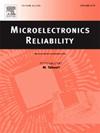10kv sic - mosfet的热力学分析,以提高焊料层的可靠性
IF 1.9
4区 工程技术
Q3 ENGINEERING, ELECTRICAL & ELECTRONIC
引用次数: 0
摘要
该研究阐明了10kv SiC-MOSFET功率模块的热机械特性,以优化芯片结构,提高其焊层可靠性。10kv SiC-MOSFET芯片尺寸为8.1 mm平方,厚度为500 μm。作为可靠性评估,对10 kV和3.3 kV sic - mosfet进行了100℃温度波动下的功率循环测试(PCT),这两种晶体管的模具尺寸、厚度和模具边缘宽度不同。两个样品都在模具下的焊料层失效。与10 kV相比,3.3 kV的失效循环次数比10 kV少30%。这个Nf差与基于三维模拟中每个循环Δ / pl的塑性应变变化计算的Nf相匹配。各种模型的3D模拟表明,较大边缘的sic - mosfet(如10 kV)具有更高的焊料寿命,因为芯片的大温度分布使焊料温度波动较小ΔTsol。研究了10 kV SiC-MOSFET晶片结构的影响,采用矩形晶片减小晶片厚度,可将Nf提高3.5倍(Δ / pl减半)。这些结果有助于通过热机械模拟实现高效的数字设计。本文章由计算机程序翻译,如有差异,请以英文原文为准。
Thermo-mechanical analysis on 10 kV SiC-MOSFETs to improve the reliability of solder layers
The study clarifies the thermo-mechanical characteristics of 10 kV SiC-MOSFET power modules to optimize die structures to improve their solder layer reliability The 10 kV SiC-MOSFET die is 8.1 mm square in size with 500 thickness. As a reliability evaluation, a power cycle test (PCT) at a temperature swing 100 C was performed on 10 kV and 3.3 kV SiC-MOSFETs, which differ in die size, thickness, and die edge width. Both samples failed in the solder layer under the die. A number of cycles to failure of 3.3 kV, which has a shorter edge, was 30% compared to 10 kV. This difference matched the calculated based on plastic strain changes per cycle from 3D simulations. 3D simulations with various models indicate that the larger edge of SiC-MOSFETs, such as 10 kV, have higher solder lifetimes because the large temperature distribution of the die makes smaller solder temperature swings . As an investigation of the influence of 10 kV SiC-MOSFET die structures, reducing the die thickness with the rectangular die shape was improved by up to 3.5 times by halving . These results contribute to achieving an efficient digital design through thermo-mechanical simulations.
求助全文
通过发布文献求助,成功后即可免费获取论文全文。
去求助
来源期刊

Microelectronics Reliability
工程技术-工程:电子与电气
CiteScore
3.30
自引率
12.50%
发文量
342
审稿时长
68 days
期刊介绍:
Microelectronics Reliability, is dedicated to disseminating the latest research results and related information on the reliability of microelectronic devices, circuits and systems, from materials, process and manufacturing, to design, testing and operation. The coverage of the journal includes the following topics: measurement, understanding and analysis; evaluation and prediction; modelling and simulation; methodologies and mitigation. Papers which combine reliability with other important areas of microelectronics engineering, such as design, fabrication, integration, testing, and field operation will also be welcome, and practical papers reporting case studies in the field and specific application domains are particularly encouraged.
Most accepted papers will be published as Research Papers, describing significant advances and completed work. Papers reviewing important developing topics of general interest may be accepted for publication as Review Papers. Urgent communications of a more preliminary nature and short reports on completed practical work of current interest may be considered for publication as Research Notes. All contributions are subject to peer review by leading experts in the field.
 求助内容:
求助内容: 应助结果提醒方式:
应助结果提醒方式:


